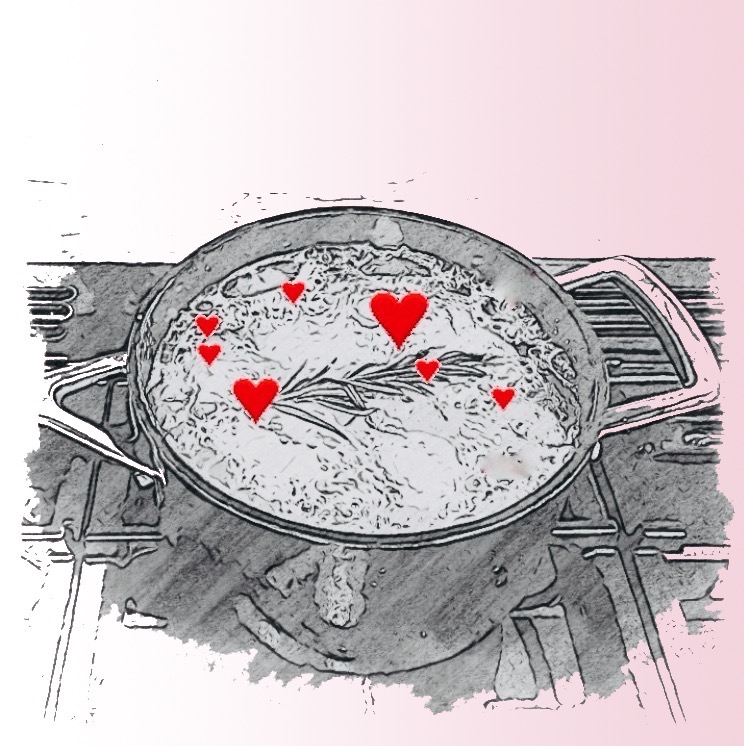Funny Pearls are proud to present our 2020 short story competition winner
BUFFALO GLUE
by Kerrie Penney
Dear Ron,
Thank you for your wisdom within the chat group and also for reaching out personally. Up to this point, I had not been using the hooves. I am embarrassed to say I had been under the impression that hoof glue was something of a myth. I am glad to hear that it is made much the same way as hide glue. Your note got me thinking that perhaps I could make a batch of hoof glue and pour it into a limb shaped mold to make a substitute for real horn. Have you tried this? I would be curious to hear your thoughts.
Sincerely,
Deirdre
Dear Deirdre,
I had not thought of creating a substitute for real horn. Your creativity is inspiring. Making hoof glue is not impossible, though it can be challenging. As I had mentioned in the chat room, while most animal glues are made from collagen, hooves are made of keratin like fingernails. Mythical? No, but it is certainly a harder material to work with. I am boiling my buffalo hooves now on the stove, and they have been going for about four hours at this point. My plan is to keep them at a slow rolling boil for the next day or so, as this will be the maximum time I think the ancient people would have been able to maintain a consistent boil.
Also, I must tell you the smell in the house is quite unusual. Of course, I have opened the windows, but the hoof when cooked is redolent. The scent is sure to cling to the towels and bedspread. Both the dogs have begun to stay very close to home, and I am wondering if I could use this somehow as an animal attractor. For animals, not people. (ha ha). I am thankful I am a bachelor, as I do not believe many women would find this an agreeable aftershave, but then I know no other woman who would be interested in creating a substitute for real horn.
Yours truly,
Ron
Dear Ron,
Thank you for your kind words. Based on the time you have estimated to boil your hooves, I have decided to run a batch in the pressure cooker. I can see there will be enough connective tissue in and around the foot to boil down and this will certainly produce some kind of glue, but I am not convinced the hooves themselves will dissolve. I shall report back.
Yours very truly,
Deirdre
Dear Deirdre,
The pot is still simmering. I did add some dog chew hoof pieces I had left from making bow tips. I ran them through my belt sander and caught the dust to ensure there would be no collagen. Just the keratin. I am assuming that if ancient people made glue from buffalo hooves, there would be no need for pressure cookers, although I deeply admire your practical thinking. Once I have rendered, I will add the acid, and will use vinegar. Certainly, ancient people would have had that.
With admiration,
Ron
Dear Ron,
I have included quite a few deer hooves in order to hopefully free the toe bones, which I use in the rattles I am making. The bones are separating nicely, and I am sure will be very clean. I plan to remove these smaller bones and will continue with the rendering of the hooves. Fingers crossed!
With fondness,
Deirdre
Dear Deirdre,
I hope you will forgive my fawning, but I had no idea you were an artist as well. I am curious about the rattles you are making. Please send a photo. I have boiled the horn dust and shaving mixture for sixteen hours now. Have strained off part of the liquid, added a touch of vinegar and placed it outside. My hope is that, upon cooling, the mixture will gel. The rest I will continue to boil to the full 24 hours. I will certainly keep you posted.
Yours,
Ron
Dear (est) Ron,
Attached please find a photo of one of my rattles. I use them in my full moon gatherings on the island. The sound is quite deep, as I place them inside a dried gourd, as depicted here. How deeply satisfying it would be to be able to use my own hoof glue to reconnect the gourd globe, rather than hot glue-gunning, and wrapping with leather thong, which is how I currently assemble them. I would be happy to send you one in the mail, if you don’t think I am being too forward?
I have some disappointing news. My experiment with the pressure cooker has not been a success. I can still quite visibly see the hoof, which did not melt down, even under the greatest pressure I could muster.
I have deeply enjoyed our conversation though, and am so pleased you helped me to remember I had all those hooves! I remain optimistic that your buffalo hooves will congeal, and you shall have a most delightful adhesive. I should also mention here, during a vision quest last evening, it was revealed to me that my spirit animal is a buffalo. What are the odds?
With great fondness,
Deirdre
Dearest Deirdre,
I don’t know what a spirit animal is, but I congratulate you. I would certainly accept your offer of a rattle. You will find my PO Box number is at the bottom of this note. I would also like to gift you some buffalo glue, which I must warn you has the most peculiar smell and consistency. However, if you are game, I shall wrap it up and post immediately. It should help keep your spirit together (ha-ha).
It has been a deep pleasure getting to know you, and I hope to continue our correspondence, if you so desire. I have never been on a vision quest, but have harvested many ungulates in my time. I am very fond of them. And may I say, fond of you.
With the greatest of fondness,
Ron
PS Did you know buffalo tongues were used by the ancient people as hairbrushes? If you are interested, I shall save you some tongue.

Kerrie Penney is a writer based in Calgary, Canada. Her poetry has appeared in blue buffalo; personal essays in the Globe and Mail, Calgary Herald and the chapbook Writing Down the Light. She is the writer and director of the documentary Cat Call: The Other C Word, has penned and narrated a short film for Burning Man’s Ursa Mater installation, and received the Hermes Creative Award for the documentary Our City Our Soul. Kerrie is a past recipient of the Banff Television Fellowship, and was selected to attend the Banff Centre Literary Arts Residency in 2017 and 2019.
